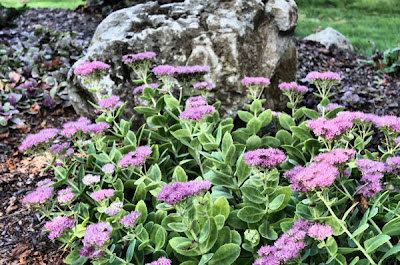Over the years as a gardener and designer I have become intrigued with the beauty and endurance of heuchera in the garden. Known originally as a shade plant, newer cultivars of heuchera have proven to be more and more tolerant of a multitude of conditions. Heuchera (Coral Bells) have made a significant rise in their appearance in gardens around the world, as newer varieties with dramatic striking foliage are cultivated. Heuchera can be grown in hardiness zones 4-9 in sun to part shade in a variety of soils. Heuchera come in a variety of colors ranging from green to chartreuse to yellow, red-pink and burgundy and serve as an excellent accent piece in the garden border, woodland or cottage garden. Since this post was originally published in 2011, after seven years of testing these perennials, here are the results.
 |
| Heuchera 'Palace Purple' Flower |
One of my all-time favorites for its durability and color is the reliable Heuchera 'Palace Purple', a cultivar with large deep maple-shaped burgundy foliage that lasts from spring until fall and even into the winter months in zones 4-9. Spikes of creamy-white flowers emerge in late summer that resemble baby's breath. If kept in part shade, the color of Heuchera 'Palace Purple' will be deeper and more dramatic but when placed in full sun its' color will range from burgundy to possibly an orange-bronze. 'Palace Purple' heuchera prefers a moist, yet well drained loamy soil. This variety has proven to be very hardy.
 |
| Heuchera 'Plum Pudding' |
The next variety worth mentioning is Heuchera 'Plum Pudding'. Plum Pudding is also tolerant in zones 4-9 and should be grown in indirect sun to part shade. The color of this heuchera is a little more on the plum side as the name indicates. I have found from experience that 'Plum Pudding' is less tolerant of full sun and does best grown in partly shady and moist conditions. It's low mounding appearance and silvery-plum foliage also makes it an excellent addition in the shade garden.
 |
| Heuchera ' Caramel' |
A newer cultivar, Heuchera 'Caramel' has become my newest favorite in the garden. 'Caramel' is hardy in zones 4-8 and performs best in partial shade to indirect sun. Caramel' will eventually spread to one to two feet in width and produces light pink flowers in June-July. This cultivar prefers medium-moist rich soil and is more tolerant of sun than its predecessors. It will thrive in a northern or eastern exposure, and when in a southern or western exposure, it is best to give this plant some afternoon shade. I have found this cultivar to be highly successful in my zone 7 garden.
 |
| Heuchera 'Solar Eclipse' |
I introduced Heuchera 'Solar Eclipse' to my garden in 2011. Showing a burst of color in a shady spot, 'Solar Eclipse' displays broadly scalloped leaves of red-brown bordered in lime green. Hardy in zones 4-9, 'Solar Eclipse' is a vigorous clump-forming grower that also prefers moist rich but well drained soil in part to full shade. I found this particular cultivar to be a beautiful addition to a shady spot; however, its lifespan was limited as compared to the others.
 |
| Heuchera villosa 'Citronelle' |
Heuchera 'Citronelle' is a hybrid stemming from 'Caramel'. 'Citronelle' is a medium grower to twelve inches in height with neon yellow lobed foliage and produces white flowers in mid-late summer. It is hardy to zones 4-9 and to -20 degrees Fahrenheit and prefers to be grown in a moist loamy soil with good drainage. 'Citronelle' will tolerate full sun in a northern or eastern exposure. I have found that the leaves can scorch if in too much sun and would not advise planting in a southern or western exposure. Even though 'Citronelle' is supposed to be more tolerant of sun, I have found 'Caramel' to be much hardier.
 |
| Heuchera 'Palace Purple' with Grasses and Norway Spruce |
Heuchera require minimal maintenance. The foliage of heuchera starts to emerge in early spring and lasts throughout the entire summer and fall. Foliage will remain throughout the winter but plants should be mulched for winter protection. An early spring pruning to remove spent foliage will encourage your Heuchera to form new growth. Heuchera display clumps of rounded, scalloped or fringed foliage that grows from 12 to 24 inches in diameter over time. Heuchera have been a favorite of mine for adding interesting foliage to the garden. There are approximately 50 varieties of Heuchera to choose from with new cultivars being developed yearly.
Since this post was originally written, there have been other exciting updates in the garden. For more information on gardening and design, check out my books:
As Always...Happy Gardening.
Author: Lee@A Guide To Northeastern Gardening Copyright 2011 (Revised 2018) All Rights Reserved.




































